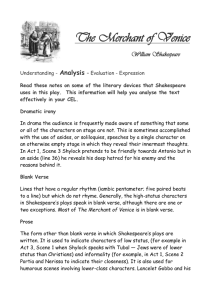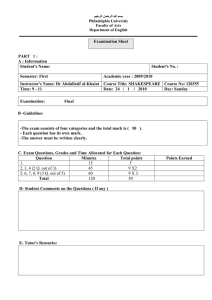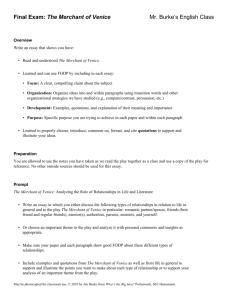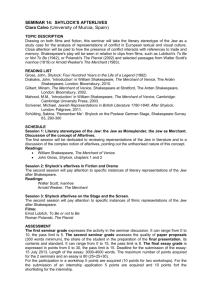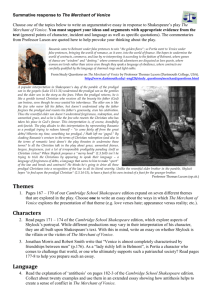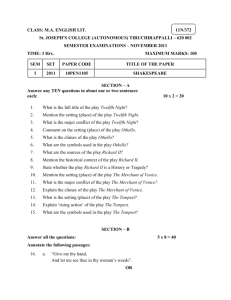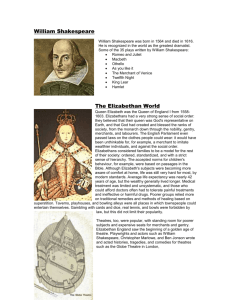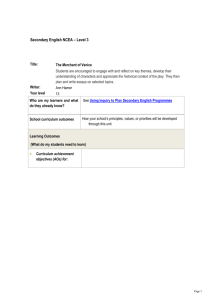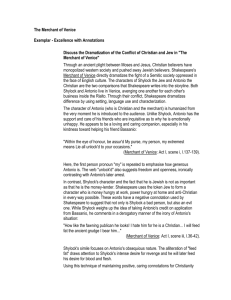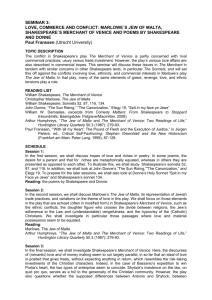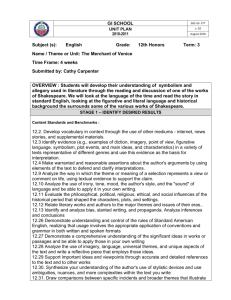Paper #2 - Kyoo Lee
advertisement
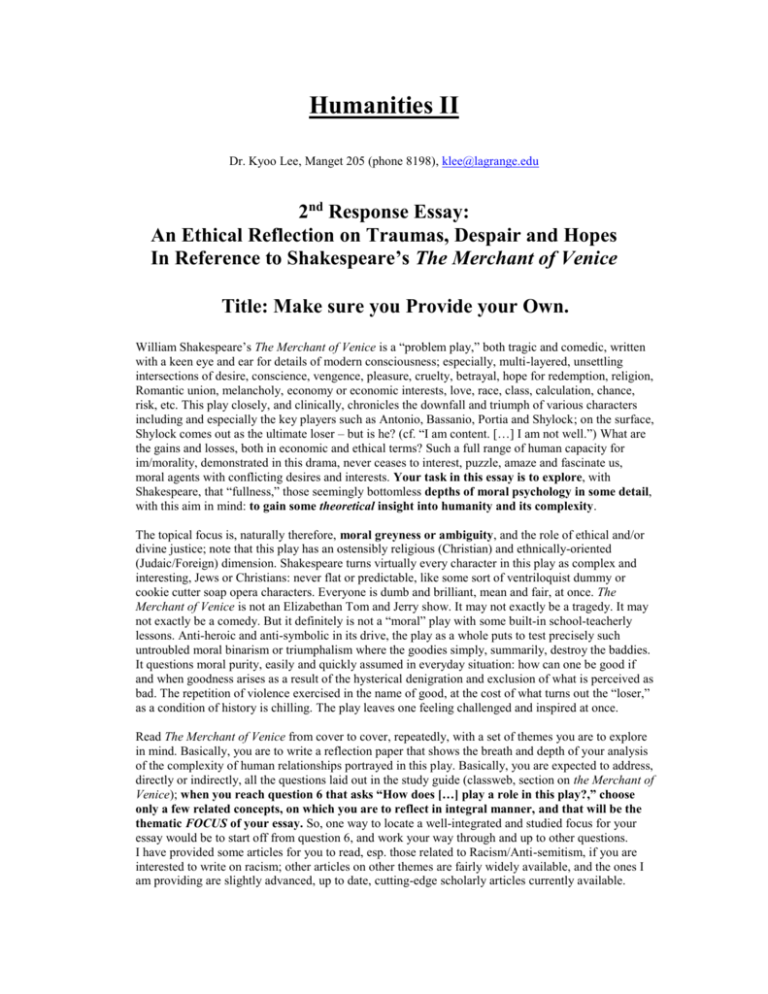
Humanities II Dr. Kyoo Lee, Manget 205 (phone 8198), klee@lagrange.edu 2nd Response Essay: An Ethical Reflection on Traumas, Despair and Hopes In Reference to Shakespeare’s The Merchant of Venice Title: Make sure you Provide your Own. William Shakespeare’s The Merchant of Venice is a “problem play,” both tragic and comedic, written with a keen eye and ear for details of modern consciousness; especially, multi-layered, unsettling intersections of desire, conscience, vengence, pleasure, cruelty, betrayal, hope for redemption, religion, Romantic union, melancholy, economy or economic interests, love, race, class, calculation, chance, risk, etc. This play closely, and clinically, chronicles the downfall and triumph of various characters including and especially the key players such as Antonio, Bassanio, Portia and Shylock; on the surface, Shylock comes out as the ultimate loser – but is he? (cf. “I am content. […] I am not well.”) What are the gains and losses, both in economic and ethical terms? Such a full range of human capacity for im/morality, demonstrated in this drama, never ceases to interest, puzzle, amaze and fascinate us, moral agents with conflicting desires and interests. Your task in this essay is to explore, with Shakespeare, that “fullness,” those seemingly bottomless depths of moral psychology in some detail, with this aim in mind: to gain some theoretical insight into humanity and its complexity. The topical focus is, naturally therefore, moral greyness or ambiguity, and the role of ethical and/or divine justice; note that this play has an ostensibly religious (Christian) and ethnically-oriented (Judaic/Foreign) dimension. Shakespeare turns virtually every character in this play as complex and interesting, Jews or Christians: never flat or predictable, like some sort of ventriloquist dummy or cookie cutter soap opera characters. Everyone is dumb and brilliant, mean and fair, at once. The Merchant of Venice is not an Elizabethan Tom and Jerry show. It may not exactly be a tragedy. It may not exactly be a comedy. But it definitely is not a “moral” play with some built-in school-teacherly lessons. Anti-heroic and anti-symbolic in its drive, the play as a whole puts to test precisely such untroubled moral binarism or triumphalism where the goodies simply, summarily, destroy the baddies. It questions moral purity, easily and quickly assumed in everyday situation: how can one be good if and when goodness arises as a result of the hysterical denigration and exclusion of what is perceived as bad. The repetition of violence exercised in the name of good, at the cost of what turns out the “loser,” as a condition of history is chilling. The play leaves one feeling challenged and inspired at once. Read The Merchant of Venice from cover to cover, repeatedly, with a set of themes you are to explore in mind. Basically, you are to write a reflection paper that shows the breath and depth of your analysis of the complexity of human relationships portrayed in this play. Basically, you are expected to address, directly or indirectly, all the questions laid out in the study guide (classweb, section on the Merchant of Venice); when you reach question 6 that asks “How does […] play a role in this play?,” choose only a few related concepts, on which you are to reflect in integral manner, and that will be the thematic FOCUS of your essay. So, one way to locate a well-integrated and studied focus for your essay would be to start off from question 6, and work your way through and up to other questions. I have provided some articles for you to read, esp. those related to Racism/Anti-semitism, if you are interested to write on racism; other articles on other themes are fairly widely available, and the ones I am providing are slightly advanced, up to date, cutting-edge scholarly articles currently available. Required Reading: Incorporate your reading of the following two, no matter what your topic is. The Textbook: William Shakespeare, The Merchant of Venice. The Folger edition is recommendable, but not strictly required; as long as your citations are adequately formal and scholarly with the precise source and bibliographic information (such as Act: Scene: Line) provided, there is no problem. Harold Bloom, “12: The Merchant of Venice,” Shakespeare: The Invention of Human, New York: Riverhead Books, 1998 [Lib Copy on Reserve][Photocopy on Reserve][Ch pdf on CD] Optional Reading: Incorporate your reading of at least two from the following list, if your topic is racism, anti-Semitism, or predominantly about issues to do with Shylock’s Jewishness, played out as such. There is no upper limit to the number of scholarly articles you can use, published in academic journals. However, the usual rule about the use of general internet source, i.e., no more than two urls, applies. R.W. Desai, ““Mislike Me Not for My Complexion” Whose Mislike? Portia’s? Shakespeare’s? Or That of His Age?” John W. Mahon et al (ed.), The Merchant of Venice: New Critical Essays, New York: Routledge, 2002. [Lib Copy on Reserve][Photocopy on Reserve][Ch pdf on CD] Cf. In ' ''Mislike Me Not For My Complexion": Whose Mislike? Portia's? Shakespeare's? Or That of His Age?' R.W. Desai posits that The Merchant depicts light-skinned characters desiring darker ones, revealing 'what may be Shakespeare's own unfashionable predilection for "black" that would run counter to the taste of his time' (305). Portia is attracted to the Prince of Morocco, Desai argues, though she ultimately suppresses and conceals that desire. At the same time, she is herself devalued by other suitors on account of being darker than them. When the six 'Northern' men who refuse the casket trial, including the English Faulconbridge, reject Portia, they act within the social order that associates geographic origin with phenotype and ranks light above dark. Sixteenth-century racism, Desai contends, is not a binary but a staircase. Moving beyond The Merchant, Desai shows that love of lighter for darker characters in contravention of social expectation is a persistent theme in the Shakespearean canon. He revisits Shakespeare's revolt against Petrarchan aesthetic convention by lauding the 'dark lady' with hair like 'black wire' and a 'dun' complexion. Desai also mentions the 'Indian child' of A Midsummer Night's Dream and its deceased mother as objects of Titania's desire. 'Was he going against the grain of his age', Desai asks, 'by expressing his own personal preference for the dark complexion?' Desai shows that Shakespeare created a stage-world in which desire opposes the socially determined hierarchy of 'complexion', suggesting that the same can and does occur in reality. http://www.hull.ac.uk/renforum/v7/nesvet.htm Ania Loomba, “Religion, Money and Race in the Merchant of Venice,” Shakespeare, Race and Colonialism, Oxford: Oxford University Press, 2005 [Photocpy on Reserve][Ch pdf on CD] Anita Gilman Sherman, “Disowning Knowledge of Jessica, or Shylock's Skepticism," Studies in English Literature 1500-1900 44.2 (2004) 277-295. [Electronic Lib: EBSCO Host] Jean-Paul Sartre, Anti-Semite and Jew: An Exploration of the Etiology of Hate, Schocken, Germany: Schocken Books, 1995 [Photocpy (excerpt) on Reserve][Ch pdf on CD] Hugh Short, “Shylock is Content: A Study in Salvation,” John W. Mahon et al (ed.), The Merchant of Venice: New Critical Essays [Lib Copy on Reserve][Photocopy on Reserve][Ch pdf on CD] Other Secondary Literature: If your topic is not directly about racism/anti-Semitism, locate on your own relevant scholarly articles, similar in quality and weight to the ones I listed above. Cite at least two, and incorporate your close and specific reading of those into your essay. If you end up using, say, one of the optional readings listed above, you are required to look for at least one more source of your own choice. There is no upper limit to the number of scholarly articles you can use, published in academic journals. However, the usual rule about the use of general internet source, i.e., no more than two urls, applies. Other Instructions Length: Five pages (minimum) to seven pages (maximum), Double-spaced. Use of Citations and Secondary sources: o o o Style: MLA or Chicago; whichever style you adopt, be consistent. Respect this formality of academic writing. It is a crucial part of your writing lesson and training. Scope: You are encouraged to use any other references deemed relevant, but strongly discouraged from relying too much on external sources (e.g., copy and paste patchwork). Web-citation: provide the URL address. Evaluation Criteria: see the evaluation rubric (cf. the syllabus) o o Be creative by all means, but be so in addition to being faithful to the instructions; your originality has to be expressed within the formalized parameters of requirements. You cannot get an A-level grade (point 8.7-9.9) on this assignment, however brilliant your thoughts are, or however long your essay is, o Without fulfilling all the criteria concerning the use of secondary sources; Without following the regulations and requirements concerning citations. Warning: a violation of honour code is a violation: “know your code.” Deadline: extremely firm; one grade point reduction per day missed.
